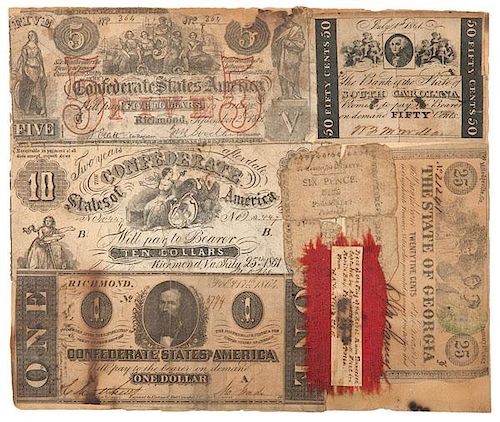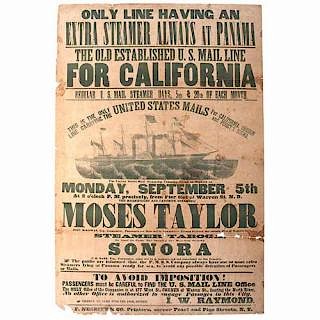Flag Relic from Rebel Ram Tennessee Captured by Admiral Farragut's Fleet at Mobile Bay, August 1864, Plus CSA Currency
About Seller
6270 Este Ave.
Cincinnati , OH 45232
United States
With offices in Cincinnati, Cleveland and Denver, Cowan’s holds over 40 auctions each year, with annual sales exceeding $16M. We reach buyers around the globe, and take pride in our reputation for integrity, customer service and great results. A full-service house, Cowan’s Auctions specializes in Am...Read more
Two ways to bid:
- Leave a max absentee bid and the platform will bid on your behalf up to your maximum bid during the live auction.
- Bid live during the auction and your bids will be submitted real-time to the auctioneer.
Bid Increments
| Price | Bid Increment |
|---|---|
| $0 | $25 |
| $500 | $50 |
| $1,000 | $100 |
| $2,000 | $250 |
| $5,000 | $500 |
| $10,000 | $1,000 |
| $20,000 | $2,500 |
| $50,000 | $5,000 |
| $100,000 | $10,000 |
About Auction
Jun 10, 2016 - Jun 11, 2016
Cowan's Auctions dawnie@cowans.com
- Lot Description
Flag Relic from Rebel Ram Tennessee Captured by Admiral Farragut's Fleet at Mobile Bay, August 1864, Plus CSA Currency
Red flag relic, approx. 2 x 3.5 in., with period annotation on the flag fragment that reads, Piece of the flag of the Rebel Ram Tennessee captured by Admiral Farragut's fleet in Mobile Bay. Friday(?) August 25th, 1864. W A Van Vleck, USN. The relic is framed together with several pieces of currency, mostly Confederate, 9 x 10.5 (sight), 13 x 14 in. including frame.
Research indicates that William A. Van Vleck graduated from the US Naval Academy and was an Acting Ensign on board the steam-sloop Ossipee in the West Gulf squadron during the Battle of Mobile Bay. After the war, he became a master on May 10, 1866; a lieutenant on February 21, 1867; and lieutenant commander on March 12, 1868. He died on June 29, 1869 at the age of 24.
Taking advantage of the swollen river, Admiral Franklin Buchanan ordered the CSS Tennessee to be launched out of Selma early and towed up the river to Mobile. The 1273-ton ship was one of the best ironclads produced for the Confederate Navy. When it reached its destination, rebel ship builders fitted the vessel with the correct iron armor and cannons in February 1863. On the morning of August 4, 1864, Rear Admiral Farragut's flagship, the USS Hartford and a fleet of warships successfully steamed into the head of the channel, launching the Battle of Mobile Bay. In a furious cloud of gun smoke and cannon fire, the battle raged in the muddy waters. With only 6 hours of coal remaining in the Tennessee, Admiral Buchanan had two choices—to flee or to fight. Buchanan chose to go out gloriously. He ordered the ship to ram into the heart of the battle and take on the entire Yankee fleet, but his boldness waned as the bleeding officer saw the precarious state of the casemate. Anticipating its collapse, he hoisted the white flag and surrendered the vessel to the Union Army. The Union captured their prize and promptly recommissioned the vessel the USS Tennessee. After some repairs it returned to the river and served with the US Navy's Mississippi Squadron until the end of the Civil War. The Navy sold it for scrapping in November 1867.
Provenance: Property of Another ConsignorGood, but has not been observed outside the frame.Condition
- Shipping Info
-
SHIPPING. At the request of the buyer, Cowan's will authorize the shipment of purchased items. Shipments usually occur within two weeks after payment has been received. Shipment is generally made via UPS Ground service. Unless buyer gives special instructions, the shipping method shall be at the sole discretion of Cowan's Auctions, Inc.. Cowan's is in no way responsible for the acts or omissions of independent handlers, packers or shippers of purchased items or for any loss, damage or delay from the packing or shipping of any property.
-
- Buyer's Premium



 EUR
EUR CAD
CAD AUD
AUD GBP
GBP MXN
MXN HKD
HKD CNY
CNY MYR
MYR SEK
SEK SGD
SGD CHF
CHF THB
THB












